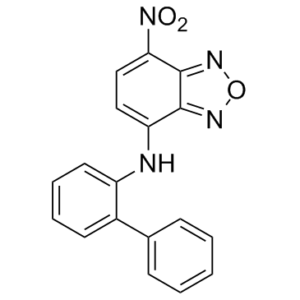10074-G5 is a potent inhibitor of c-Myc-Max dimerization and interaction with an IC50 of 146 μM and with anticancer activities. The binding and distortion of the bHLH-ZIP domain of c-Myc by 10074-G5 results in the inhibition of both the transcriptional activity and the formation of the c-Myc/Max heterodimer. 10074-G5 hampered c-Myc/Max dimerization and delayed the growth of Daudi Burkitt's lymphoma cells in vitro. The C.B-17 SCID mice treated with 20 mg/kg 10074-G5 intravenously for 5 days in a row showed no growth inhibition of Daudi xenografts after the treatment. Neither two nor twenty-four hours following treatment showed any inhibition of c-Myc/Max dimerization in Daudi xenografts.
Physicochemical Properties
| Molecular Formula | C18H12N4O3 | |
| Molecular Weight | 332.31 | |
| Exact Mass | 332.09 | |
| Elemental Analysis | C, 64.67; H, 4.22; N, 16.76; O, 14.36 | |
| CAS # | 413611-93-5 | |
| Related CAS # |
|
|
| PubChem CID | 2836600 | |
| Appearance | Pink to red solid powder | |
| Density | 1.4±0.1 g/cm3 | |
| Boiling Point | 538.6±60.0 °C at 760 mmHg | |
| Flash Point | 279.5±32.9 °C | |
| Vapour Pressure | 0.0±1.4 mmHg at 25°C | |
| Index of Refraction | 1.719 | |
| LogP | 4.97 | |
| Hydrogen Bond Donor Count | 1 | |
| Hydrogen Bond Acceptor Count | 6 | |
| Rotatable Bond Count | 3 | |
| Heavy Atom Count | 25 | |
| Complexity | 466 | |
| Defined Atom Stereocenter Count | 0 | |
| SMILES | O=[N+]([O-])C1=CC=C(NC2=CC=CC=C2C3=CC=CC=C3)C4=NON=C41 |
|
| InChi Key | KMJPYSQOCBYMCF-UHFFFAOYSA-N | |
| InChi Code | InChI=1S/C18H12N4O3/c23-22(24)16-11-10-15(17-18(16)21-25-20-17)19-14-9-5-4-8-13(14)12-6-2-1-3-7-12/h1-11,19H | |
| Chemical Name | 4-nitro-N-(2-phenylphenyl)-2,1,3-benzoxadiazol-7-amine | |
| Synonyms |
|
|
| HS Tariff Code | 2934.99.9001 | |
| Storage |
Powder-20°C 3 years 4°C 2 years In solvent -80°C 6 months -20°C 1 month |
|
| Shipping Condition | Room temperature (This product is stable at ambient temperature for a few days during ordinary shipping and time spent in Customs) |
Biological Activity
| Targets | Daudi cells (IC50 = 15.6 μM); HL-60 cells (IC50 = 13.5 μM); c-Myc–Max (IC50 = 146 μM) | |
| ln Vitro |
|
|
| ln Vivo |
|
|
| Enzyme Assay | With a 146 μM IC50 and anticancer properties, 10074-G5 is a strong inhibitor of c-Myc-Max dimerization and interaction. By binding to and altering the bHLH-ZIP domain of c-Myc, 10074-G5 prevents the formation of the c-Myc/Max heterodimer and its transcriptional activity. | |
| Cell Assay | After dissolving in DMSO, 10074-G5 is diluted with culture medium. In logarithmic growth, Daudi cells or HL-60 cells are exposed to 10074-G5 (1-100 μM). Each well receives 50 μL of 1 mg/mL MTT after 72 hours, and it is then incubated for 4 hours. Upon completion of the incubation period, the drug-containing medium and MTT are extracted from each well, and 100 μl of DMSO is added. A 5-minute shaking period is then observed. It reads the absorbance at 570 nm[1]. | |
| Animal Protocol |
|
|
| References |
[1]. In vitro cytotoxicity and in vivo efficacy, pharmacokinetics, and metabolism of 10074-G5, a novel small-molecule inhibitor of c-Myc/Max dimerization. J Pharmacol Exp Ther. 2010 Dec;335(3):715-27. [2]. Discovery of methyl 4'-methyl-5-(7-nitrobenzo[c][1,2,5]oxadiazol-4-yl)-[1,1'-biphenyl]-3-carboxylate, an improved small-molecule inhibitor of c-Myc-max dimerization. ChemMedChem. 2014 Oct;9(10):2274-85. [3]. Pharmacophore identification of c-Myc inhibitor 10074-G5. Bioorg Med Chem Lett. 2013 Jan 1;23(1):370-4. |
Solubility Data
| Solubility (In Vitro) |
|
|||
| Solubility (In Vivo) |
Solubility in Formulation 1: ≥ 2.5 mg/mL (7.52 mM) (saturation unknown) in 10% DMSO + 40% PEG300 + 5% Tween80 + 45% Saline (add these co-solvents sequentially from left to right, and one by one), clear solution. For example, if 1 mL of working solution is to be prepared, you can add 100 μL of 25.0 mg/mL clear DMSO stock solution to 400 μL PEG300 and mix evenly; then add 50 μL Tween-80 to the above solution and mix evenly; then add 450 μL normal saline to adjust the volume to 1 mL. Preparation of saline: Dissolve 0.9 g of sodium chloride in 100 mL ddH₂ O to obtain a clear solution. Solubility in Formulation 2: ≥ 2.5 mg/mL (7.52 mM) (saturation unknown) in 10% DMSO + 90% Corn Oil (add these co-solvents sequentially from left to right, and one by one), clear solution. For example, if 1 mL of working solution is to be prepared, you can add 100 μL of 25.0 mg/mL clear DMSO stock solution to 900 μL of corn oil and mix evenly. (Please use freshly prepared in vivo formulations for optimal results.) |
| Preparing Stock Solutions | 1 mg | 5 mg | 10 mg | |
| 1 mM | 3.0092 mL | 15.0462 mL | 30.0924 mL | |
| 5 mM | 0.6018 mL | 3.0092 mL | 6.0185 mL | |
| 10 mM | 0.3009 mL | 1.5046 mL | 3.0092 mL |
